Hey y'all! Watch this!
I have hundreds of jars of model
paint that I bought
while I was stationed in
Germany. I left
Germany years ago and have
been building flying models since being back in the states. These small
jars of hobby paints
have been sitting around with the pigment settling in the bottom of the jars
all this time.
I pulled out a scrap of wood about 1/16" x 1/8" and stirred the paint in
one of the jars and the pigment just stayed balled up on the end of the stick.
The paint hasn't gone bad but considering I'll be using several different
colors in the near future, I wanted to find a better way than spending an hour
stirring each jar of paint.
Robart makes a paint shaker that I've never used or even seen in action,
but all accounts from those I know who own one say it's a useless machine.
I don't know that it doesn't work but it's expensive enough that I took
people's word for it.
I don't know of anything else made to mix small jars of hobby paint.
I looked around my shop trying to find something that would do the job.
One thing I've done in the past is bend a wire such that it has a loop on one
end and chuck the other end into my drill. It didn't work very well and
I couldn't keep paint from coming out of the jar and running down the side.
I didn't want to repeat that experiment.
I don't know what made me think of it, but when I saw my scroll saw I
realized I had something that had the exact mechanical motion necessary to do
the job.
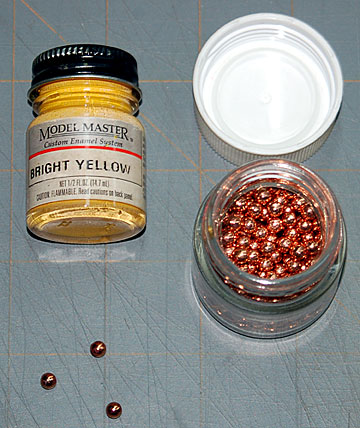 |
A tip that was passed to me a long time ago is to add
copper BB's to your paint to help mix the paint. I usually use two
or three BB's. Be sure to use copper. Steel BB's can
corrode or rust and ruin your paint - particularly if you use water-base
acrylic paints such as Tamiya brand.
It works very well for hand-shaking paint that isn't too settled but it's
usefulness is limited when the paint has gotten fairly old. |
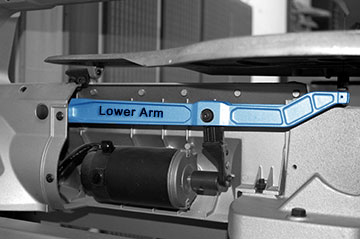 |
The upper arm has a guard around it which means I'd have
to do a lot of disassembly to get at it. I could have rigged an
attachment for the paint near the blade but I didn't want to throw the
saw that far out of balance. I'm trying to mix paint — not ruin my
saw. In that same vein, these small bottles of plastic paints
are the largest bottles I will use the scroll saw to shake.
Anything bigger than that is asking for destroyed bearings in the saw
and jars of paint flying through the shop. Note: It's a good idea to put a heavy-duty blade in the saw.
A fine blade breaks more easily. If you own a scroll saw and have had a blade break you know how
nerve-shattering it is when that happens. I have no idea what will happen if a blade breaks when a jar of
paint is attached but I don't want to find out. I always install a heavy-duty blade and ensure it is
secured properly. |
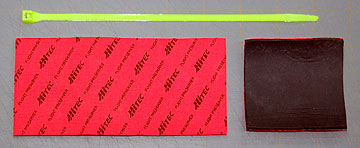 |
You'll notice on my scroll saw there are several reliefs
in the lower arm. Those are very useful as they help secure the
paint jar. Use a type of firm foam rubber that has a good grip
to it. This is neoprene foam that comes with Hitec receivers.
Cloth material is adhered to one side of the foam. |
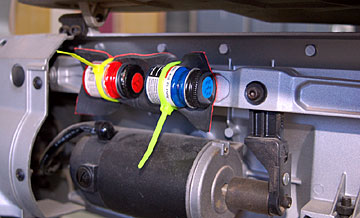 |
Put a Zip tie around the arm in the general location
where the paint jar will go. Feed the loose end through the
locking end just a couple clicks. Slide the foam against the
scroll saw arm and under the Zip tie.
Important! The cloth side of the foam should be against the
arm. The foam side of the foam contacts the paint jar.
Tighten the zip ties down snugly.
Tug on the paint jars and ensure they are very secure. You
really don't want these coming loose!
I put the jars close to the eccentric arm from the motor so that I
wouldn't throw off the saw's balance too much. |
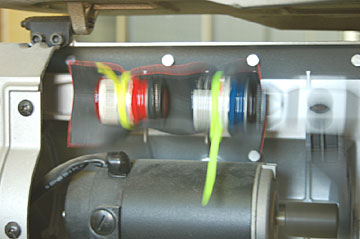 |
My scroll saw is variable speed. Low speed is
extremely slow and that's the setting I put the saw before I turned it
on. I observed closely and slowly turned the saw speed up until it
was about 3/4 of its highest speed. It seemed to work like a
charm, so I just let it run for about a minute.
When I shut off the saw I managed to work the paint jar out without
cutting the Zip tie. I used the same tie for a couple more jars of
paint but checked that the tie was snug each time.
The method works better than anything else I've tried. It's
fast and requires way less effort than stirring tiny jars of paint with
a toothpick. |
|
![]()